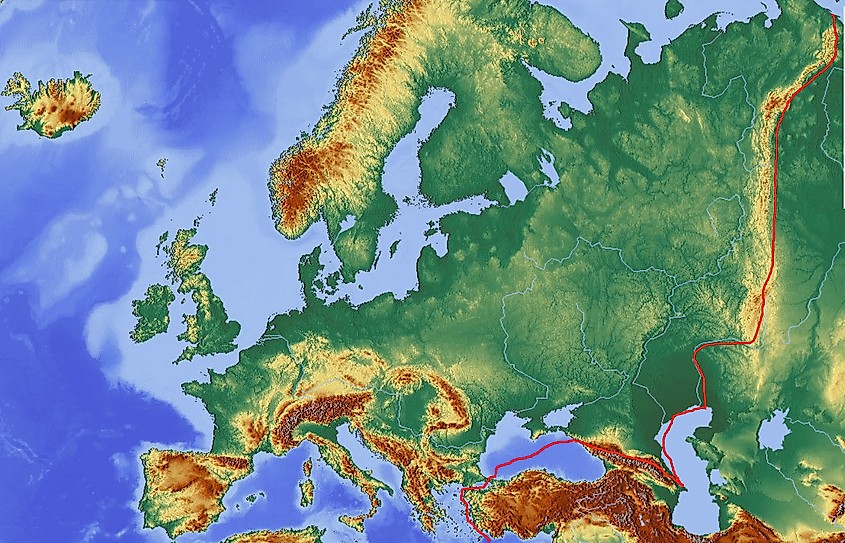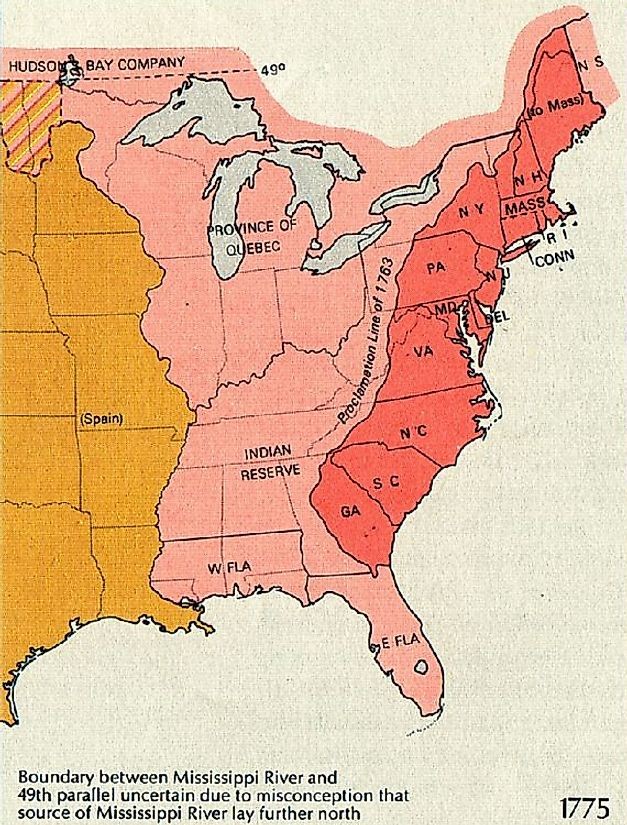The United States and Europe have comparable land areas, prompting frequent comparisons. At COMPARE.EDU.VN, we provide detailed insights into these comparisons, helping you understand the nuances between the two. Explore key differences in population, economy, and more with COMPARE.EDU.VN. Discover insightful comparisons and make informed decisions with our comprehensive analysis.
1. How Does The United States Size Compare To Europe In Land Area?
While both the United States and Europe cover nearly 10 million square kilometers, Europe is slightly larger. Europe spans approximately 9,938,000 square kilometers (3,837,083 square miles), while the United States covers about 9,833,520 square kilometers (3,796,742 square miles). This difference of 104,480 square kilometers is roughly the size of Iceland.
Europe’s land area is distributed among 47 countries, with Russia accounting for the largest portion (3,972,400 square kilometers within Europe). Vatican City is the smallest, at just 0.49 square kilometers. The United States, comprising 50 states, sees Alaska as its largest state at 1,723,337 square kilometers, and Rhode Island as the smallest at 4,002 square kilometers.
2. What Are The Population Differences Between The United States And Europe?
Europe’s population significantly outweighs that of the United States. As of 2024, Europe has approximately 745 million residents, more than double the U.S. population of around 342 million.
Russia is the most populous country in Europe, with about 110 million people residing on its European side. In contrast, Vatican City has the smallest population, with roughly 825 residents. Within the United States, California is the most populous state, with over 39 million residents, while Wyoming is the least populous, with about 581,000 residents.
3. How Do The Economies Of The United States And Europe Compare?
The United States has a slightly larger economy than Europe in terms of nominal GDP. The U.S. boasts a GDP per capita (PPP) of $85,372 and a nominal GDP of $28.78 trillion, making it the country with the largest economy.
California, as the largest state economy, has a nominal GDP of $3.8 trillion, surpassing even India’s economy. Europe is home to many wealthy countries, including Luxembourg, which leads globally with a GDP per capita (PPP) of $143,742. Germany has Europe’s largest economy, with a nominal GDP of approximately $3.85 trillion. As a whole, Europe’s economy has a nominal GDP of $24.22 trillion, about 84% the size of the United States’ economy.
4. How Do Driving Distances Compare Between The United States And Europe?
Driving across the United States and Europe involves similar distances, both exceeding 5,000 kilometers. However, the European route is slightly longer.
Driving from Hammerfest, Norway, to Sagres, Portugal, covers 5,490 kilometers (3,411 miles), requiring about 58 hours of non-stop driving. In the U.S., driving from Seattle, Washington, to Miami, Florida, spans 5,311 kilometers (3,300 miles), taking about 48 hours non-stop. This comparison excludes Alaska, as it would necessitate driving through Canada.
5. What Are The Historical Differences In Size And Evolution Between The United States And Europe?
The United States is a relatively young country compared to many in Europe. Some European countries, like San Marino (founded in 301 CE) and Denmark (dating back to 700-800 CE), have histories stretching back millennia, while France traces its origins to 843. The United States, in contrast, is just under 250 years old.
Initially, the U.S. consisted of thirteen states along the eastern Atlantic coast. Key expansions include the Louisiana Purchase in 1803, which doubled the country’s land area, and the acquisition of Florida from Spain in 1819. Further expansion occurred through the annexation of Texas in 1845 and the Oregon Treaty with Britain in 1848. Alaska and Hawaii became the final two states in 1959, adding significantly to the U.S.’s total land area.
6. What Are Key Statistics Comparing The Size Of The United States And Europe?
Here’s a table summarizing key statistics comparing the size of the United States and Europe:
| Feature | United States | Europe |
|---|---|---|
| Land Area | 9,833,520 sq km (3,796,742 sq mi) | 9,938,000 sq km (3,837,083 sq mi) |
| Population | ~342 million | ~745 million |
| Largest State/Country | Alaska (1,723,337 sq km) | Russia (3,972,400 sq km in Europe) |
| Smallest State/Country | Rhode Island (4,002 sq km) | Vatican City (0.49 sq km) |
| Largest Economy | California (GDP $3.8 trillion) | Germany (GDP ~$3.85 trillion) |





7. How Does Population Density Differ Between The United States And Europe?
Europe has a significantly higher population density than the United States. With approximately 745 million people living in an area slightly larger than the U.S., Europe’s population density is much greater.
The United States, with around 342 million people, has a lower population density. This difference impacts infrastructure, resource management, and overall living conditions. Urban areas in Europe are often more densely populated compared to their U.S. counterparts.
8. What Are The Cultural And Linguistic Differences Between The United States And Europe?
Europe is incredibly diverse culturally and linguistically, contrasting with the relatively more homogenous United States. The European Union alone has 24 official languages, and over 200 languages are spoken across the continent.
Each European country boasts unique customs, traditions, and historical influences. The United States, while diverse, generally shares a common language and more unified cultural identity. This diversity in Europe affects everything from business practices to social interactions.
9. How Do Economic Systems Differ Between The United States And Europe?
The United States and Europe have different economic systems. The U.S. tends to lean towards a more free-market capitalist approach, while many European countries embrace social market economies with stronger social safety nets.
European countries often have higher tax rates and more comprehensive welfare programs. The U.S. typically has lower taxes but less extensive social services. These differences impact income distribution, healthcare, and overall economic equality.
10. What Are Some Common Misconceptions About The Size And Scale Of The United States And Europe?
A common misconception is that the United States and Europe are roughly the same in every aspect due to their similar land masses. While their sizes are comparable, significant differences exist in population, culture, and economic structure.
Another misconception is that Europe is a single, unified entity like the United States. Europe is a continent comprising many independent countries with their own governments, cultures, and economies. Understanding these distinctions is crucial for accurate comparisons.
11. How Do Infrastructure And Urban Planning Compare Between The United States And Europe?
Europe often boasts more developed public transportation systems and denser urban planning compared to the United States. Many European cities prioritize pedestrian and bicycle-friendly infrastructure.
The United States, with its vast land area, often relies more on personal vehicles and suburban sprawl. Public transportation is generally less extensive, and urban planning tends to be more car-centric. These differences affect sustainability, traffic congestion, and overall quality of life.
12. How Do Healthcare Systems Differ Between The United States And Europe?
Healthcare systems vary significantly between the United States and Europe. Many European countries offer universal healthcare coverage, ensuring all citizens have access to medical care.
The United States relies on a mix of private and public insurance, leading to disparities in access and affordability. European healthcare systems are often funded through taxes, while the U.S. system involves employer-sponsored insurance and out-of-pocket expenses.
13. How Do Education Systems Compare Between The United States And Europe?
Education systems also differ between the United States and Europe. Many European countries offer tuition-free or low-cost higher education, making it more accessible to a broader range of students.
The United States typically has higher tuition costs, leading to student loan debt. European education systems often emphasize standardized testing and vocational training, while the U.S. system offers more flexibility and a broader range of academic options.
14. What Role Does Geography Play In Shaping The United States And Europe?
Geography significantly influences the development of both the United States and Europe. The U.S.’s vast interior plains have supported large-scale agriculture, while its extensive coastline has facilitated trade.
Europe’s diverse geography, from the mountains of Switzerland to the coastal regions of the Netherlands, has shaped its varied cultures and economies. Access to natural resources and navigable waterways has been crucial for Europe’s historical and economic development.
15. How Do Political Systems Differ Between The United States And Europe?
The United States and Europe have distinct political systems. The U.S. operates as a federal republic with a presidential system, while Europe comprises many different countries with various forms of government, including parliamentary democracies and constitutional monarchies.
European countries often have multi-party systems and coalition governments. The U.S. has a two-party system, leading to different political dynamics and policy outcomes.
16. What Impact Does Technology Have On The United States And Europe?
Technology plays a crucial role in both the United States and Europe. The U.S. is a global leader in technological innovation, particularly in software, internet services, and biotechnology.
Europe also has strong technology sectors, especially in manufacturing, renewable energy, and automotive engineering. Both regions are investing heavily in artificial intelligence, cybersecurity, and other emerging technologies.
17. How Does The Legal System Differ Between The United States And Europe?
The legal systems in the United States and Europe have different foundations and structures. The U.S. legal system is based on common law, relying on judicial precedents and case law.
Many European countries follow civil law, which emphasizes codified statutes and legal codes. These differences affect legal procedures, rights, and overall justice administration.
18. How Do Transportation Networks Compare Between The United States And Europe?
Europe often has more extensive and integrated transportation networks compared to the United States. High-speed rail, efficient public transit, and well-maintained road networks are common features in Europe.
The United States relies more on air travel and personal vehicles, with a less developed high-speed rail system. European transportation policies often prioritize sustainability and reducing carbon emissions.
19. How Do Environmental Policies Differ Between The United States And Europe?
Environmental policies vary between the United States and Europe. Many European countries have adopted stricter environmental regulations and committed to ambitious climate goals.
The U.S. has a more varied approach, with some states and regions leading in environmental protection while others lag. European policies often emphasize renewable energy, energy efficiency, and reducing pollution.
20. What Are The Implications Of These Differences For Global Relations?
The differences between the United States and Europe have significant implications for global relations. These differences in foreign policy, trade, and security cooperation can lead to both cooperation and tension on the international stage. Understanding these nuances is vital for navigating global challenges and fostering effective partnerships.
21. How Do Consumer Preferences Differ Between The United States And Europe?
Consumer preferences in the United States and Europe can vary significantly due to cultural, economic, and historical factors.
United States:
- Cars: Larger vehicles like SUVs and trucks are more popular due to longer distances and a preference for space.
- Food: Larger portion sizes and a preference for convenience foods are common. Fast food chains have a strong presence.
- Fashion: More casual and comfort-oriented clothing styles are generally preferred.
- Technology: Early adoption of new technologies and a strong interest in the latest gadgets are prevalent.
- Home Appliances: Larger appliances, like oversized refrigerators and laundry machines, are common due to bigger living spaces.
Europe:
- Cars: Smaller, more fuel-efficient cars are preferred due to narrower roads and higher fuel costs.
- Food: Emphasis on fresh, locally sourced ingredients. Smaller portion sizes and a culture of enjoying meals are more common.
- Fashion: More emphasis on style and quality, with a greater appreciation for designer brands and tailored clothing.
- Technology: A more balanced approach to technology adoption, with a focus on reliability and sustainability.
- Home Appliances: Smaller, more energy-efficient appliances are preferred due to smaller living spaces and environmental concerns.
22. How Do Work-Life Balance Priorities Differ Between The United States And Europe?
Work-life balance priorities in the United States and Europe reflect differing cultural values and labor laws.
United States:
- Vacation Time: Generally fewer mandated vacation days compared to Europe. It’s common for employees to receive two weeks of paid vacation annually.
- Work Hours: Longer work hours are more common. A 40-hour work week is standard, but many professionals often work more.
- Parental Leave: Limited federal mandates for parental leave. Some states offer more comprehensive benefits, but it’s often shorter than European standards.
- Work Culture: A strong emphasis on career advancement and productivity. “Presenteeism” (being present at work even when not productive) can be valued.
- Healthcare: Healthcare is often tied to employment, which can influence job decisions and reduce mobility.
Europe:
- Vacation Time: Generous vacation allowances are mandated by law. Many countries require at least four to six weeks of paid vacation per year.
- Work Hours: Shorter work hours are more common, with a greater emphasis on maintaining a healthy work-life balance.
- Parental Leave: Comprehensive parental leave policies are standard. Parents often receive several months of paid leave to care for newborns.
- Work Culture: Emphasis on leisure and personal time. Overworking is generally discouraged, and there is more value placed on hobbies and family life.
- Healthcare: Universal healthcare systems reduce the pressure on employment-based benefits, allowing for greater job mobility and less stress.
23. What Are The Main Differences In Attitudes Towards Sustainability Between The U.S. And Europe?
Attitudes towards sustainability differ significantly between the United States and Europe, driven by varying cultural values and policy frameworks.
United States:
- Environmental Regulations: Vary widely by state, with some states leading in environmental protection and others lagging.
- Consumer Behavior: A growing interest in sustainable products, but convenience and cost often outweigh environmental concerns for many consumers.
- Energy Consumption: Higher per capita energy consumption compared to Europe, partly due to larger homes and more car-dependent lifestyles.
- Policy Focus: Incentives and technological solutions are often favored over strict regulations.
Europe:
- Environmental Regulations: More stringent and consistent environmental regulations across countries.
- Consumer Behavior: Strong emphasis on eco-friendly products and sustainable living practices. Consumers are often willing to pay more for environmentally responsible options.
- Energy Consumption: Lower per capita energy consumption due to smaller living spaces, efficient public transportation, and higher energy costs.
- Policy Focus: A mix of regulations, incentives, and public awareness campaigns to promote sustainability.
24. How Do Attitudes Towards Gun Ownership Differ Between The United States And Europe?
Attitudes toward gun ownership are markedly different between the United States and Europe, influenced by historical, cultural, and legal factors.
United States:
- Legal Framework: The Second Amendment of the U.S. Constitution guarantees the right to bear arms.
- Gun Ownership Rates: Significantly higher rates of gun ownership compared to Europe.
- Cultural Perspective: Gun ownership is often viewed as a constitutional right and a means of self-defense.
- Gun Laws: Vary widely by state, with some states having very permissive gun laws and others having stricter regulations.
Europe:
- Legal Framework: Gun ownership is generally viewed as a privilege regulated by the state rather than an individual right.
- Gun Ownership Rates: Lower rates of gun ownership compared to the United States.
- Cultural Perspective: Gun ownership is less ingrained in the culture and is often associated with hunting or sport shooting.
- Gun Laws: Stricter gun control laws across most countries, including requirements for licensing, registration, and safe storage.
25. What Are The Differences In Approaches To Urban Planning And Development?
Approaches to urban planning and development differ significantly between the United States and Europe, reflecting varying priorities and cultural values.
United States:
- Urban Sprawl: More common due to a preference for single-family homes and car-dependent lifestyles.
- Zoning Laws: Often prioritize single-use zoning, separating residential, commercial, and industrial areas.
- Public Transportation: Less emphasis on public transportation, with many cities heavily reliant on cars.
- Infrastructure: Focus on road infrastructure to accommodate suburban growth.
Europe:
- Compact Cities: Emphasis on compact, mixed-use urban development to reduce sprawl and promote walkability.
- Zoning Laws: Mixed-use zoning is more common, allowing for a mix of residential, commercial, and cultural activities in the same area.
- Public Transportation: Extensive public transportation networks, including trains, trams, and buses, are common.
- Infrastructure: Investment in public transportation and pedestrian-friendly infrastructure.
26. How Do Attitudes To Immigration And Multiculturalism Differ?
Attitudes towards immigration and multiculturalism vary across the United States and Europe, influenced by historical, social, and political factors.
United States:
- Historical Context: A nation built by immigrants, with a history of welcoming diverse populations.
- Immigration Policy: Debates over immigration policy are ongoing, with varying levels of support for different approaches.
- Cultural Integration: Emphasis on assimilation, with immigrants expected to adopt American cultural norms.
- Public Discourse: Divided opinions on immigration, with concerns about economic impacts and national security.
Europe:
- Historical Context: Colonial history has shaped immigration patterns and attitudes towards multiculturalism.
- Immigration Policy: Policies vary by country, with some nations adopting more open policies and others taking a more restrictive approach.
- Cultural Integration: Emphasis on integration, with efforts to promote social cohesion while respecting cultural diversity.
- Public Discourse: Debates over immigration and cultural identity are common, with concerns about integration challenges and cultural preservation.
27. How Do Food Culture And Dining Habits Compare?
Food culture and dining habits in the United States and Europe reflect distinct culinary traditions and social customs.
United States:
- Dining Style: More casual, with an emphasis on convenience and speed.
- Cuisine: Diverse, influenced by global flavors, often with larger portion sizes and fast-food options.
- Social Dining: Eating out is common, with a strong emphasis on fast service and casual settings.
- Tipping: Tipping is customary, with servers relying on tips as a significant portion of their income.
Europe:
- Dining Style: More formal and leisurely, with a focus on enjoying the dining experience.
- Cuisine: Emphasis on regional specialties, fresh ingredients, and traditional cooking methods.
- Social Dining: Meals are often seen as social events, with longer dining times and more emphasis on conversation.
- Tipping: Tipping is less common, as servers are typically paid a living wage.
28. What Are The Differences In Approaches To Retirement And Social Security?
Approaches to retirement and social security differ significantly between the United States and Europe, reflecting varying social welfare models and economic priorities.
United States:
- Social Security: A government-funded program providing retirement, disability, and survivor benefits.
- Retirement Savings: Emphasis on individual retirement savings through 401(k)s and IRAs.
- Retirement Age: The full retirement age is gradually increasing to 67.
- Healthcare: Healthcare costs in retirement can be a significant concern, as Medicare coverage has limitations.
Europe:
- Social Security: More generous government-funded pension systems providing comprehensive retirement benefits.
- Retirement Savings: Less reliance on individual retirement savings, with a greater emphasis on state-funded pensions.
- Retirement Age: Retirement ages vary by country but are generally around 65.
- Healthcare: Universal healthcare systems ensure that retirees have access to medical care without significant out-of-pocket expenses.
29. How Do Perspectives On National Identity And Patriotism Differ?
Perspectives on national identity and patriotism vary between the United States and Europe, influenced by historical, cultural, and political contexts.
United States:
- National Identity: Strong sense of national identity, often tied to values of freedom, democracy, and opportunity.
- Patriotism: Overt displays of patriotism are common, including flag waving and expressions of national pride.
- Individualism: Emphasis on individual achievement and self-reliance, often linked to the American Dream.
- Civic Engagement: Active participation in civic life, including voting and community involvement.
Europe:
- National Identity: More complex and nuanced sense of national identity, often intertwined with regional and cultural identities.
- Patriotism: More reserved expressions of patriotism compared to the United States, with a greater emphasis on national heritage and cultural traditions.
- Collectivism: Emphasis on social cohesion and collective responsibility, with a strong social safety net.
- Civic Engagement: High levels of civic engagement, including participation in political activism and social movements.
30. What Are The Key Differences In Education Systems?
Education systems differ significantly between the United States and Europe, reflecting varying educational philosophies and funding models.
United States:
- Structure: A mix of public and private schools, with local control over curriculum and funding.
- Higher Education: Diverse range of colleges and universities, with high tuition costs and significant student loan debt.
- Standardized Testing: Emphasis on standardized testing for college admissions and academic assessment.
- Extracurricular Activities: Strong emphasis on extracurricular activities, including sports and clubs.
Europe:
- Structure: Predominantly public education systems, with national standards and funding.
- Higher Education: Many countries offer tuition-free or low-cost higher education, making it more accessible.
- Standardized Testing: Emphasis on standardized testing at key transition points, such as secondary school admissions.
- Extracurricular Activities: Less emphasis on extracurricular activities compared to the United States, with more focus on academic pursuits.
COMPARE.EDU.VN provides comprehensive comparisons to help you make informed decisions. Whether you’re comparing cultural values, economic systems, or education models, we offer the insights you need.
Navigating the comparisons between the United States and Europe can be complex. At COMPARE.EDU.VN, we simplify the process, offering detailed and objective analyses to help you make informed decisions.
FAQ: United States Size Compared To Europe
1. Is Europe bigger than the US in terms of land area?
Yes, Europe is slightly larger than the United States in terms of land area. Europe covers approximately 9,938,000 square kilometers, while the United States covers about 9,833,520 square kilometers.
2. Which has a larger population, the US or Europe?
Europe has a significantly larger population than the United States. Europe’s population is approximately 745 million, while the United States has around 342 million residents.
3. How does the US economy compare to Europe’s economy?
The United States has a slightly larger economy than Europe in terms of nominal GDP. The U.S. boasts a nominal GDP of $28.78 trillion, while Europe’s economy has a nominal GDP of $24.22 trillion.
4. Which country in Europe has the largest economy?
Germany has the largest economy in Europe, with a nominal GDP of approximately $3.85 trillion.
5. What is the smallest country in Europe by land area?
Vatican City is the smallest country in Europe by land area, covering just 0.49 square kilometers.
6. How do driving distances across the US and Europe compare?
Driving across the United States and Europe involves similar distances, both exceeding 5,000 kilometers. The European route from Hammerfest, Norway, to Sagres, Portugal, is slightly longer than the U.S. route from Seattle, Washington, to Miami, Florida.
7. How does population density differ between the US and Europe?
Europe has a much higher population density than the United States. With a larger population in a slightly larger area, Europe’s population is more concentrated compared to the U.S.
8. What are some key cultural differences between the US and Europe?
Europe is incredibly diverse culturally and linguistically, with 24 official languages in the European Union alone. The United States, while diverse, generally shares a common language and more unified cultural identity.
9. How do healthcare systems differ between the US and Europe?
Many European countries offer universal healthcare coverage, ensuring all citizens have access to medical care. The United States relies on a mix of private and public insurance, leading to disparities in access and affordability.
10. What are some common misconceptions about comparing the US and Europe?
A common misconception is that the United States and Europe are roughly the same due to their similar land masses. While their sizes are comparable, significant differences exist in population, culture, and economic structure.
Are you struggling to compare different options and make the best decision? Visit COMPARE.EDU.VN today! Our comprehensive comparison tools and detailed analyses will help you weigh the pros and cons, understand the key differences, and confidently choose the option that best fits your needs. Don’t stay confused – empower yourself with the information you need at compare.edu.vn. For further assistance, contact us at 333 Comparison Plaza, Choice City, CA 90210, United States, Whatsapp: +1 (626) 555-9090.
